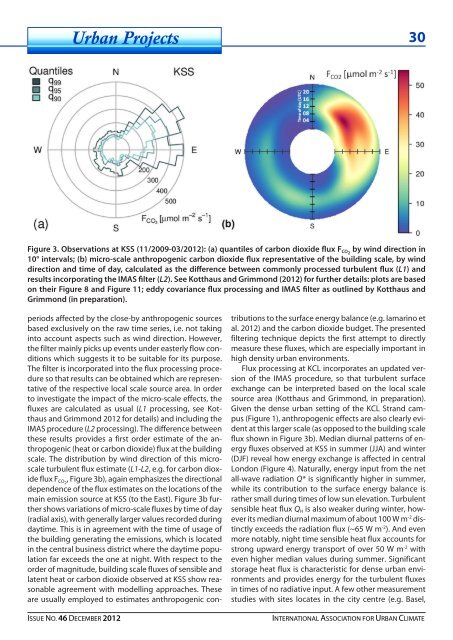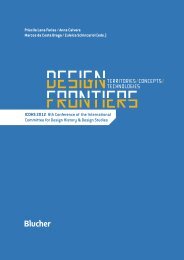Urban Climate News - FAU
Urban Climate News - FAU
Urban Climate News - FAU
Create successful ePaper yourself
Turn your PDF publications into a flip-book with our unique Google optimized e-Paper software.
<strong>Urban</strong> Projects 30<br />
Figure 3. Observations at KSS (11/2009-03/2012): (a) quantiles of carbon dioxide flux F CO2 by wind direction in<br />
10° intervals; (b) micro-scale anthropogenic carbon dioxide flux representative of the building scale, by wind<br />
direction and time of day, calculated as the difference between commonly processed turbulent flux (L1) and<br />
results incorporating the IMAS filter (L2). See Kotthaus and Grimmond (2012) for further details: plots are based<br />
on their Figure 8 and Figure 11; eddy covariance flux processing and IMAS filter as outlined by Kotthaus and<br />
Grimmond (in preparation).<br />
periods affected by the close-by anthropogenic sources<br />
based exclusively on the raw time series, i.e. not taking<br />
into account aspects such as wind direction. However,<br />
the filter mainly picks up events under easterly flow conditions<br />
which suggests it to be suitable for its purpose.<br />
The filter is incorporated into the flux processing procedure<br />
so that results can be obtained which are representative<br />
of the respective local scale source area. In order<br />
to investigate the impact of the micro-scale effects, the<br />
fluxes are calculated as usual (L1 processing, see Kotthaus<br />
and Grimmond 2012 for details) and including the<br />
IMAS procedure (L2 processing). The difference between<br />
these results provides a first order estimate of the anthropogenic<br />
(heat or carbon dioxide) flux at the building<br />
scale. The distribution by wind direction of this microscale<br />
turbulent flux estimate (L1-L2, e.g. for carbon dioxide<br />
flux F CO2 , Figure 3b), again emphasizes the directional<br />
dependence of the flux estimates on the locations of the<br />
main emission source at KSS (to the East). Figure 3b further<br />
shows variations of micro-scale fluxes by time of day<br />
(radial axis), with generally larger values recorded during<br />
daytime. This is in agreement with the time of usage of<br />
the building generating the emissions, which is located<br />
in the central business district where the daytime population<br />
far exceeds the one at night. With respect to the<br />
order of magnitude, building scale fluxes of sensible and<br />
latent heat or carbon dioxide observed at KSS show reasonable<br />
agreement with modelling approaches. These<br />
are usually employed to estimates anthropogenic con-<br />
tributions to the surface energy balance (e.g. Iamarino et<br />
al. 2012) and the carbon dioxide budget. The presented<br />
filtering technique depicts the first attempt to directly<br />
measure these fluxes, which are especially important in<br />
high density urban environments.<br />
Flux processing at KCL incorporates an updated version<br />
of the IMAS procedure, so that turbulent surface<br />
exchange can be interpreted based on the local scale<br />
source area (Kotthaus and Grimmond, in preparation).<br />
Given the dense urban setting of the KCL Strand campus<br />
(Figure 1), anthropogenic effects are also clearly evident<br />
at this larger scale (as opposed to the building scale<br />
flux shown in Figure 3b). Median diurnal patterns of energy<br />
fluxes observed at KSS in summer (JJA) and winter<br />
(DJF) reveal how energy exchange is affected in central<br />
London (Figure 4). Naturally, energy input from the net<br />
all-wave radiation Q* is significantly higher in summer,<br />
while its contribution to the surface energy balance is<br />
rather small during times of low sun elevation. Turbulent<br />
sensible heat flux Q H is also weaker during winter, however<br />
its median diurnal maximum of about 100 W m -2 distinctly<br />
exceeds the radiation flux (~65 W m -2 ). And even<br />
more notably, night time sensible heat flux accounts for<br />
strong upward energy transport of over 50 W m -2 with<br />
even higher median values during summer. Significant<br />
storage heat flux is characteristic for dense urban environments<br />
and provides energy for the turbulent fluxes<br />
in times of no radiative input. A few other measurement<br />
studies with sites locates in the city centre (e.g. Basel,<br />
ISSUE NO. 46 DECEMBER 2012 INTERNATIONAL ASSOCIATION FOR URBAN CLIMATE
















